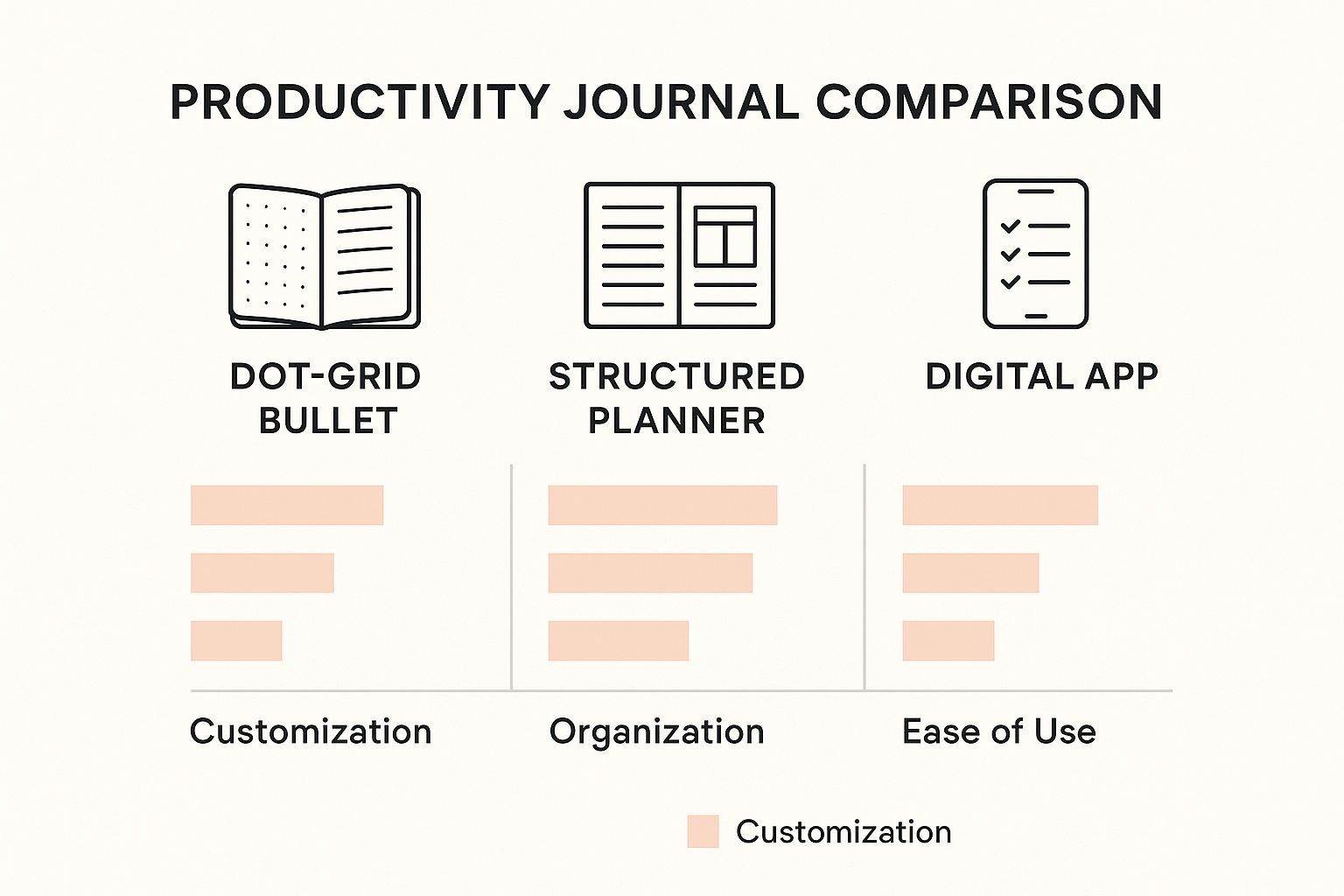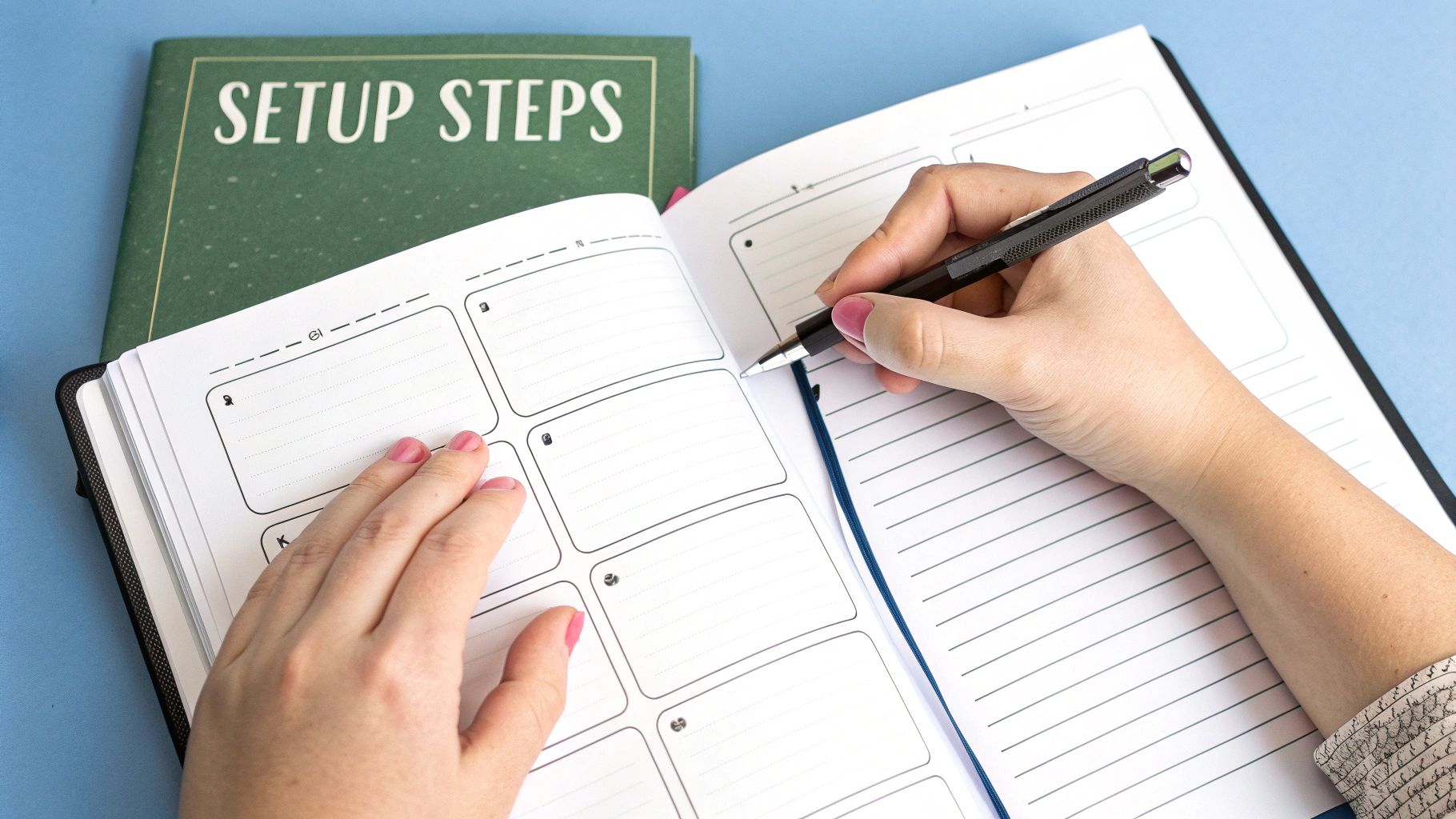Imagine harnessing a secret weapon for your ambitions—a simple tool that sharpens your focus, silences the noise, and transforms your dreams into decisive daily actions. This is the incredible power of using journals for productivity. It's not just about writing things down; it's about architecting a life of purpose and intention.
Your Personal Command Center for Clarity and Focus
A productivity journal is far more than a to-do list; it’s your personal command center. It’s the space where you strategically map out your mission, align your actions with your deepest values, and consciously direct your most precious resource: your attention. This single habit can revolutionize your approach, shifting you from merely being busy to being truly effective.

The physical act of writing crystallizes your thoughts. According to a study from the Association for Psychological Science, students who took notes by hand demonstrated better conceptual understanding than those who typed. This suggests that writing on paper creates a more powerful cognitive connection, making you far more likely to follow through on your plans.
This intentional approach is gaining momentum. The global journal software market, valued at $1.2 billion in 2023, is projected to soar to $2.3 billion by 2032. This isn't just a trend; it's a worldwide movement toward tools that help us find clarity in the chaos.
Creating an Environment for Success
Your physical space powerfully shapes your mental state. A cluttered desk breeds a cluttered mind, derailing your focus before you even begin. The goal is to design an environment that invites concentration and inspires deep work.
Your journal is a tool for building momentum. Each entry, no matter how small, is a step forward—a declaration of intent that moves you closer to your goals.
Cultivating an atmosphere that supports productivity is key. For inspiration on creating a calming, focused space, explore ideas for a minimalist bedroom design for a serene space. This intentional design fosters the exact mental clarity you need for your journaling practice to thrive.
Your First Action Point
Ready to ignite your journey? Tonight, take just five minutes. Write down the single most important task for tomorrow—the one thing that, if accomplished, will make the biggest impact. This small, decisive act is your first step toward forging an unstoppable habit.
The Science of Why Productivity Journaling Works
Have you ever wondered how some people achieve so much, seemingly without effort? Their secret isn't more hours; it's a smarter system for managing focus and energy. Using journals for productivity is a science-backed method for unlocking peak performance, and it all begins with your brain.

The simple act of writing engages a part of your brain called the Reticular Activating System (RAS). Think of the RAS as your brain's internal filter; it decides what information gets your attention. When you physically write down a goal, you're telling your RAS, "This is a priority."
Suddenly, your brain begins to actively scan your environment for opportunities, resources, and ideas aligned with what you’ve written. This isn't magic—it's neuroscience. You're programming your focus to work for you, spotting connections you might have otherwise missed.
Freeing Up Your Mental Bandwidth
Our working memory is like a computer's RAM—it has a limited capacity. When we try to juggle every task, deadline, and idea in our heads, we create cognitive overload. This mental clutter leads to stress and makes deep, focused work nearly impossible.
A productivity journal acts as an external hard drive for your mind. As Dr. David Allen, creator of the "Getting Things Done" methodology, puts it, "Your mind is for having ideas, not holding them." By offloading thoughts onto paper, you free up incredible mental energy for what truly matters: creative problem-solving and executing your most important tasks.
"Journaling is the act of slowing down to listen to yourself. It externalizes your thoughts, allowing you to see them with a clarity that the busy mind can rarely achieve on its own."
This is why journaling brings such a profound sense of calm and control. You're no longer reacting to chaos; you're proactively designing your focus. The global business productivity software market, valued at USD 98.25 billion in 2023 and projected to hit USD 183.23 billion by 2030, reflects this massive shift towards smarter ways of working.
Your Actionable First Step
Ready to experience this mental freedom right now? Try this simple but powerful exercise.
- Perform a "Brain Dump": Grab a blank page and for 10 minutes, write down everything on your mind. Every task, worry, idea, and reminder—get it all out.
- Don't Filter, Just Flow: The goal isn't organization; it's liberation. Let the thoughts pour onto the page without judgment.
- Feel the Clarity: Once you're done, take a deep breath. That feeling of lightness? That's the mental space you've just created to finally focus on what matters most.
Choosing Your Ideal Journaling System
The most powerful productivity journal isn’t the fanciest—it's the one you look forward to using every day. Finding the right system is a personal choice, like finding a trusted partner for your ambitions. You need a tool that feels less like a chore and more like a natural extension of your mind.
Your first decision is between the timeless appeal of a paper journal and the modern convenience of a digital one. This choice sets the stage for how you'll connect with your goals each day.
Analog: The Power of Pen and Paper
There's a special magic in putting pen to paper. It's a deliberate, screen-free ritual that slows racing thoughts and deepens your connection to your intentions. The physical act of writing engages your brain differently than typing, improving memory and retention.
This hands-on approach offers complete freedom. A blank notebook can become anything—a minimalist to-do list, a creative planner filled with sketches, or a detailed mind map. If you're drawn to structured yet flexible methods, explore the surprising benefits of bullet journaling to see how a simple notebook can transform your organization.
Digital: The Advantage of Accessibility
Digital journals for productivity offer a suite of features that analog can't match. With an app, your plans are always with you, synced across all your devices. This makes it effortless to capture a fleeting idea or check your schedule on the go.
Digital systems excel at organization, offering searchable archives, customizable templates, and seamless integration with your calendar. The demand for these tools is exploding—the digital journal apps market is projected to leap from USD 6.68 billion in 2025 to a massive USD 13.81 billion by 2034.
The infographic below highlights some popular journal types and what makes each unique.

Analog vs Digital Journals For Productivity
Still deciding? This table breaks down the key differences between pen-and-paper and digital journaling to help you find the perfect fit for your life and style.
| Feature | Analog Journal (Pen & Paper) | Digital Journal (App or Software) |
|---|---|---|
| Flexibility | Unmatched freedom. A blank page can be anything you imagine—a mind map, a sketch, a traditional list. | Often structured by templates. Customization is possible but usually within the app’s framework. |
| Portability | Limited to the physical notebook. Can be bulky to carry everywhere. | Highly portable. Your journal is available on any device you own (phone, tablet, computer). |
| Tactile Experience | The sensory act of writing can improve focus, memory, and mindfulness. It’s a screen-free ritual. | Lacks physical sensation. Typing can be faster but may feel less personal or intentional. |
| Organization | Relies on manual systems like indexes, tabs, or color-coding. Finding old entries can take time. | Excellent organization. Features searchable archives, tags, and automated sorting. |
| Durability | Vulnerable to damage, loss, or theft. No backups unless you manually scan pages. | Secure and backed up. Your data is usually saved to the cloud, protecting it from loss. |
| Distractions | A dedicated, distraction-free space for your thoughts. No notifications or pop-ups. | Can be distracting. The temptation to check email or social media is just a click away. |
Ultimately, whether you choose the mindful ritual of an analog journal or the powerful convenience of a digital one, the goal is the same: to find a system that makes staying organized feel joyful and effortless.
The right journaling system removes friction. It should feel so natural to use that it becomes an indispensable part of your daily routine.
There is no universally "best" option. The perfect journal is the one that aligns with your personality, workflow, and biggest dreams—the one you'll love opening every single day.
Building Your High-Impact Productivity Journal
A blank page holds infinite promise, but it can also feel intimidating. The secret to transforming that empty notebook into your most powerful productivity tool is structure. An effective journal isn't just a place for random thoughts; it’s a purpose-built system where every element works together to deliver tangible results.

Think of it like building a high-performance vehicle. You need an engine to power you forward (your goals), a steering wheel to guide you (your priorities), a dashboard to monitor progress (your habits), and a GPS to stay on course (your reflections). When these components work in harmony, you can go wherever you want, faster and with complete control.
Laying the Foundation with Strategic Goals
Your goals are the North Star of your journal. Without them, a to-do list is just a collection of chores. Define your goals with absolute clarity to give your daily actions meaning.
- Big Picture Vision: Dedicate a section to your long-term dreams—what you want to achieve in the next year or five years. This connects your daily grind to a bigger, more inspiring purpose.
- Quarterly Milestones: Break those massive goals into smaller, quarterly objectives. This makes them feel achievable and gives you clear targets for the near future.
- Weekly Sprints: Each week, define 1-3 key priorities that move you closer to your quarterly milestones. This is where your grand vision becomes concrete, actionable steps.
Prioritizing Your Daily Actions
Not all tasks are created equal. A great productivity journal helps you cut through the noise and zero in on what truly matters. One of the best tools for this is the Eisenhower Matrix, which sorts tasks by urgency and importance.
The secret to productivity isn’t managing time—it’s managing your focus. Your journal is the tool that directs that focus where it will have the greatest impact.
This simple framework forces you to be intentional with your energy. By learning to separate what's truly important from what's just loud, you stop reacting to your day and start commanding it with purpose.
Tracking Progress and Building Momentum
Incredible achievements are the result of small, consistent actions repeated over time. A habit tracker is a simple yet profound tool for visualizing your progress and building unstoppable momentum.
By tracking key behaviors—like exercising, reading, or dedicating time to a passion project—you create a visible chain of success. Research shows that tracking progress significantly increases the likelihood of sticking with your goals. Seeing those checkmarks accumulate provides a daily dose of motivation and reinforces the positive changes you're making.
The Power of Scheduled Reflection
Finally, a high-impact journal is a tool for learning and growth. Without reflection, you're just busy. With it, you're constantly evolving.
Set aside time for a weekly or monthly review to ask a few powerful questions:
- What went well this week? Celebrate your wins, no matter how small.
- What were the biggest challenges? Identify roadblocks without judgment.
- What will I do differently next week? Turn insights into actionable improvements.
This simple ritual is the engine of personal growth, ensuring you're not just spinning your wheels but actively moving forward. For more ideas on how to frame your entries, discover fantastic tips on how to journal effectively.
Powerful Techniques to Supercharge Your Focus
Once your journal's foundation is set, it's time to bring it to life with powerful techniques. These methods are the secret sauce that transforms a simple notebook into a high-performance tool for clarity and achievement.
Think of your journal as a personal operating system. These strategies are the apps you can install to supercharge your workflow. Let's move beyond basic to-do lists and explore proven methods that build momentum, sharpen focus, and help you master your day. This is where the magic happens.
Embrace Flexibility with the Bullet Journal Method
The Bullet Journal method, or BuJo, is beloved for its beautiful simplicity and total adaptability. It’s less a pre-made planner and more a framework that empowers you to design a system perfectly suited to how your brain works.
At its core, the method uses "rapid logging"—short, bulleted notes—to quickly capture tasks, thoughts, and events.
It’s the perfect system for anyone who feels confined by traditional planners. You can create custom sections, or "collections," for anything you can imagine, from project outlines to books you want to read, all tied together with a simple index.
"The Bullet Journal method is about the 'why' behind the 'what.' It’s a mindfulness practice disguised as a productivity system."
Its true power lies in its fluid, mindful approach. When a task isn't finished, you don't just copy it to the next day. You intentionally "migrate" it, forcing a moment of reflection: Is this still important? This small act keeps you conscious and in control of your commitments.
Master Your Day with Time Blocking
Do you ever reach the end of the day and wonder where the hours went? Time Blocking might be your new best friend. This technique involves scheduling your entire day, not just your appointments.
You assign a specific block of time for every task, from deep work on a major project to answering emails and taking a coffee break.
Imagine your day as a blank puzzle. Time Blocking helps you fit all the pieces together intentionally, ensuring your most important work gets your best energy.
- Action Point: At the start of your day, identify your top 1-3 priorities. Estimate the time each will take and schedule those blocks into your journal first. Then, fill in the rest of your day around them. Treat these blocks as unbreakable appointments with your goals.
This strategy is a powerful antidote to multitasking. It trains your brain to focus intensely on one thing at a time, giving every minute a clear mission.
Build Momentum with a Done List
While a to-do list focuses on the future, a Done List celebrates the present—and it provides a surprisingly powerful psychological boost.
Instead of staring at a mountain of unfinished tasks, you create a running log of everything you accomplish throughout the day. No task is too small to include.
This simple shift in perspective is incredibly motivating. Seeing a tangible record of your achievements builds momentum and combats that nagging feeling of an "unproductive day." On tough days, your Done List serves as concrete proof of your effort and progress, building the confidence you need for tomorrow's challenges.
How to Build a Consistent Journaling Habit
A world-class productivity system is worthless if it just gathers dust. The real challenge isn't finding the perfect journal; it's building the habit of using it daily. The secret? Make journaling so simple and rewarding that it becomes a non-negotiable part of your day.
Forget the pressure to write pages from the start. Overwhelm is the enemy of consistency. Instead, start ridiculously small. Commit to writing just one sentence a day. That's it. This tiny action lowers the barrier so much that you have no excuse not to do it, laying the groundwork for a lasting ritual.
Anchor Your New Habit
One of the most effective ways to make a new habit stick is habit stacking. You simply link your new journaling practice to a routine you already do without thinking.
The formula is simple: After [current habit], I will [new habit]. For instance, "After I pour my morning coffee, I will write in my journal for five minutes."
- Morning Ritual: Place your journal right next to your coffee maker or on your breakfast table.
- Evening Wind-Down: Keep your journal on your nightstand to capture your thoughts before turning off the lights.
This simple connection helps the new behavior feel automatic over time. You’re not trying to find extra time; you’re cleverly weaving it into the moments you already own.
Design Your Environment for Success
Your surroundings have a huge impact on your behavior. If your journal is buried under a pile of papers, you'll resist the effort it takes to even start. Make it visible, inviting, and easy to grab.
Perfection is the enemy of progress. A messy, inconsistent journal that you actually use is infinitely more valuable than a beautiful, empty one.
If you miss a day—or a week—don't let it derail you. The goal isn't a perfect, unbroken chain; it's to create a reliable tool that serves you. Just open it to a fresh page and begin again. Your journal is there to support you, not judge you. Every new entry is a win.
A Few Common Questions
How Much Time Should I Spend Journaling Every Day?
Start with just 5-10 minutes a day. The real power comes from consistency, not duration.
A few focused minutes in the morning to set your intentions, or a quick reflection before bed, is far more effective than a long session once a month. Once the habit feels effortless, you can expand the time as you see fit.
What if I Miss a Day?
It will happen! When it does, extend yourself grace. One missed day doesn't erase your progress.
Remember, this journal is a tool to support you—it's not another deadline. Simply pick it up the next day and continue forward. The goal is progress, not perfection.
Is a Digital or Physical Journal Better?
There's no single right answer. The "better" journal is the one you will use consistently and joyfully.
Physical journals offer a beautiful, screen-free space for focused thought. Digital journals are fantastic for searching entries, syncing across devices, and automated backups. Feel free to experiment and see which one resonates with your style.
At Mesmos, we believe in the transformative power of putting your intentions on paper. Our journals are thoughtfully designed to be the perfect companion on your journey to clarity and focus. Discover a journal that inspires you and start building a more intentional life today.
